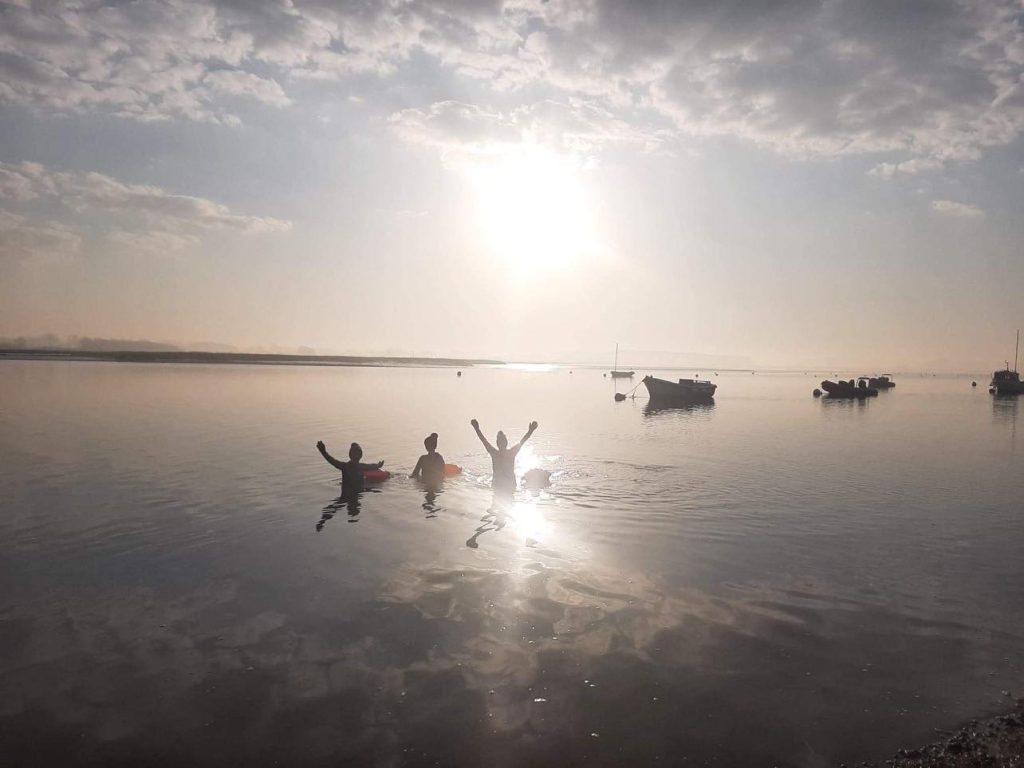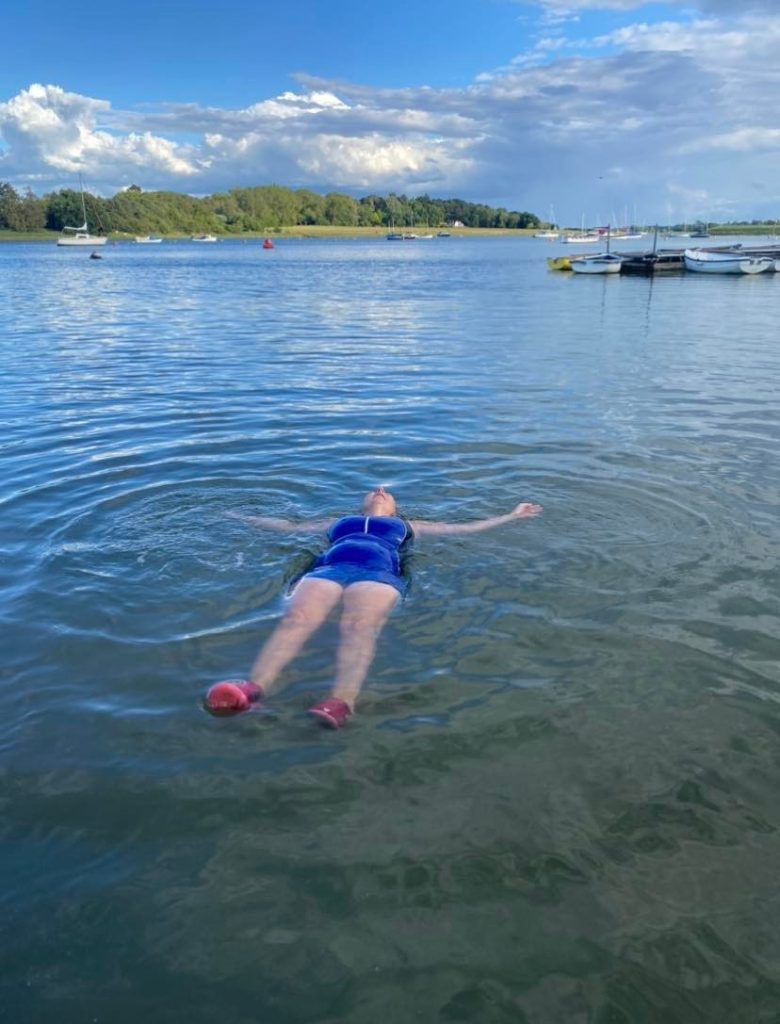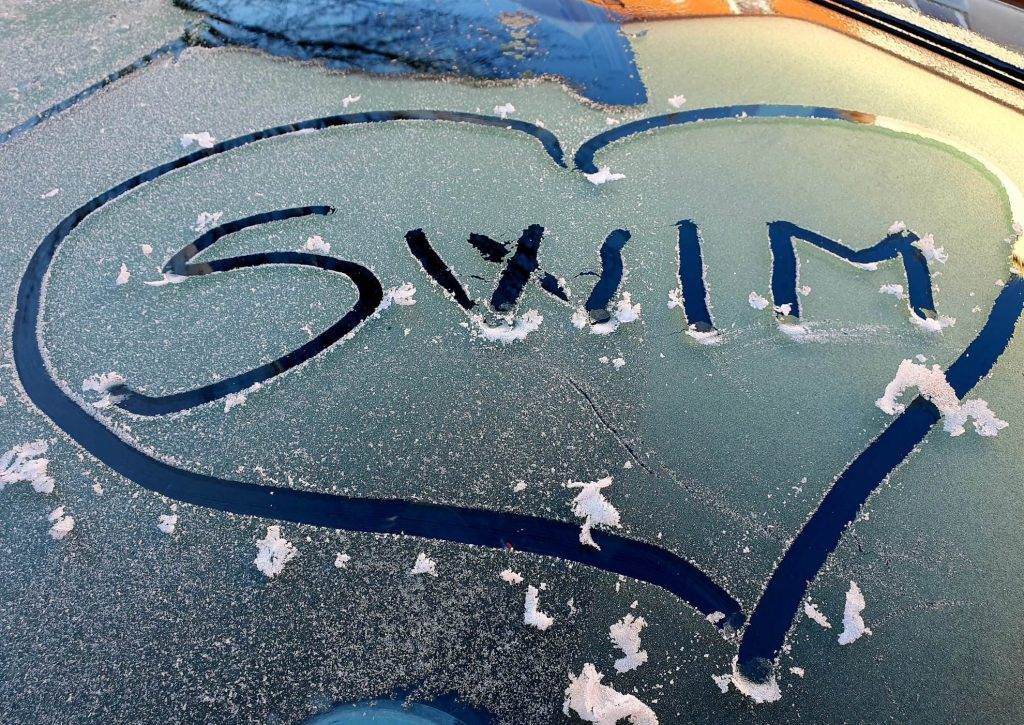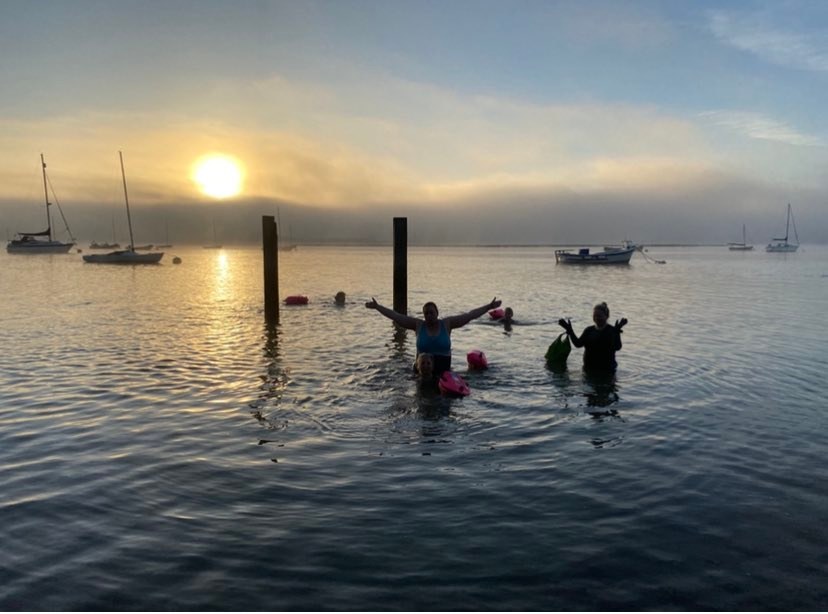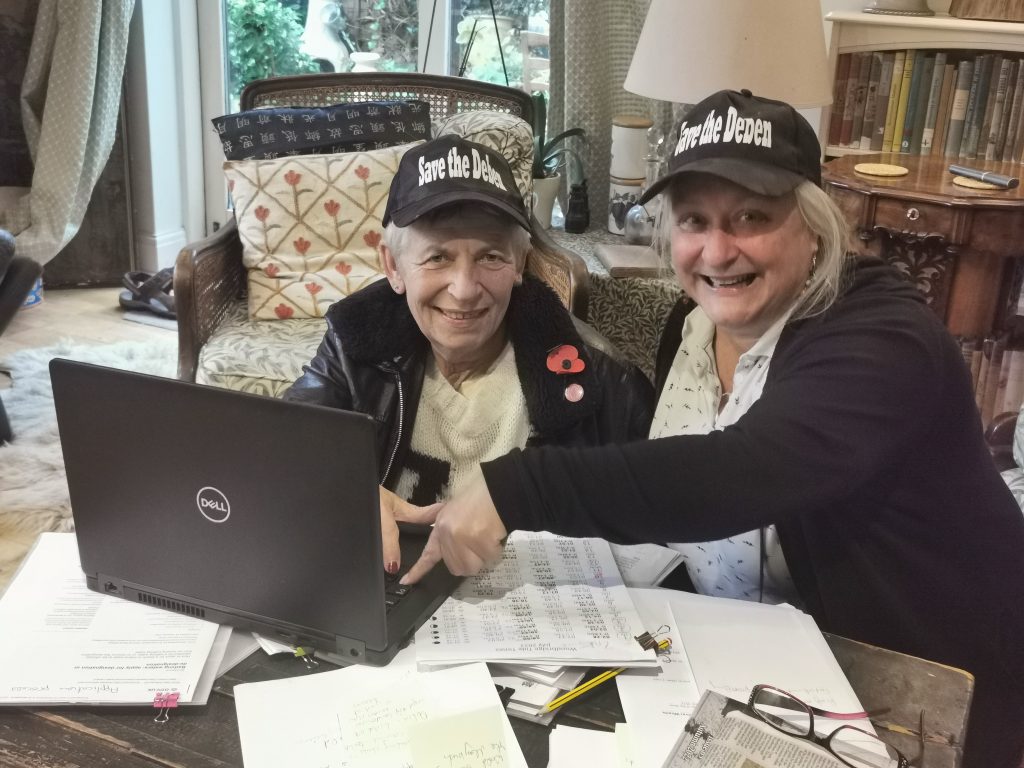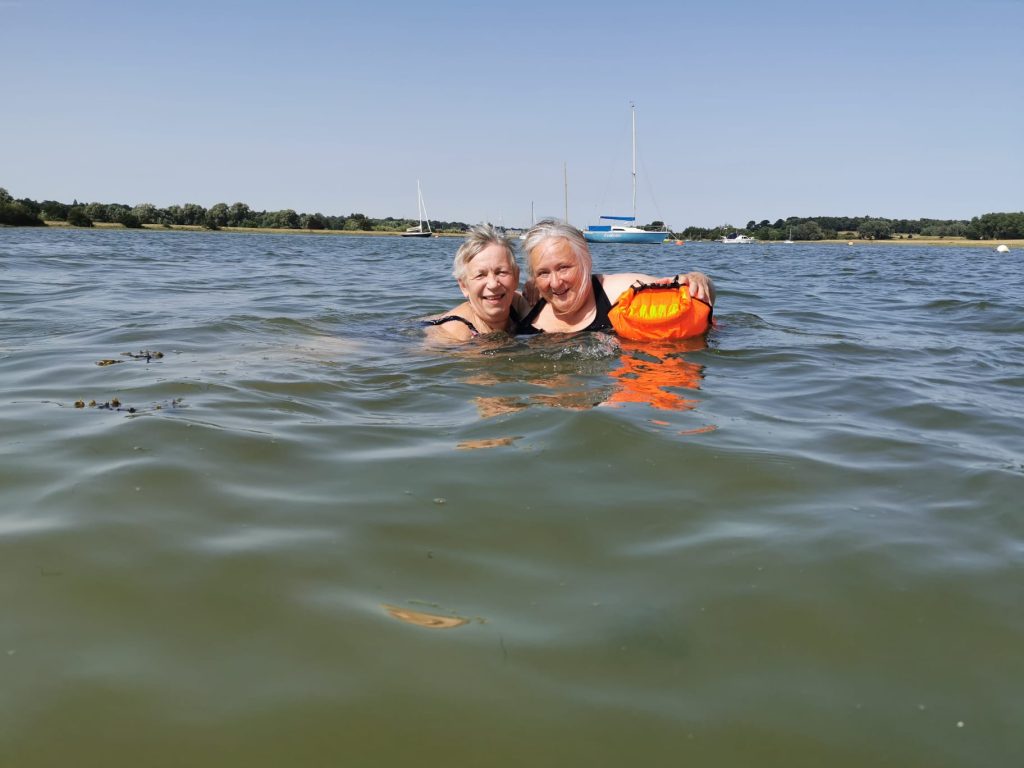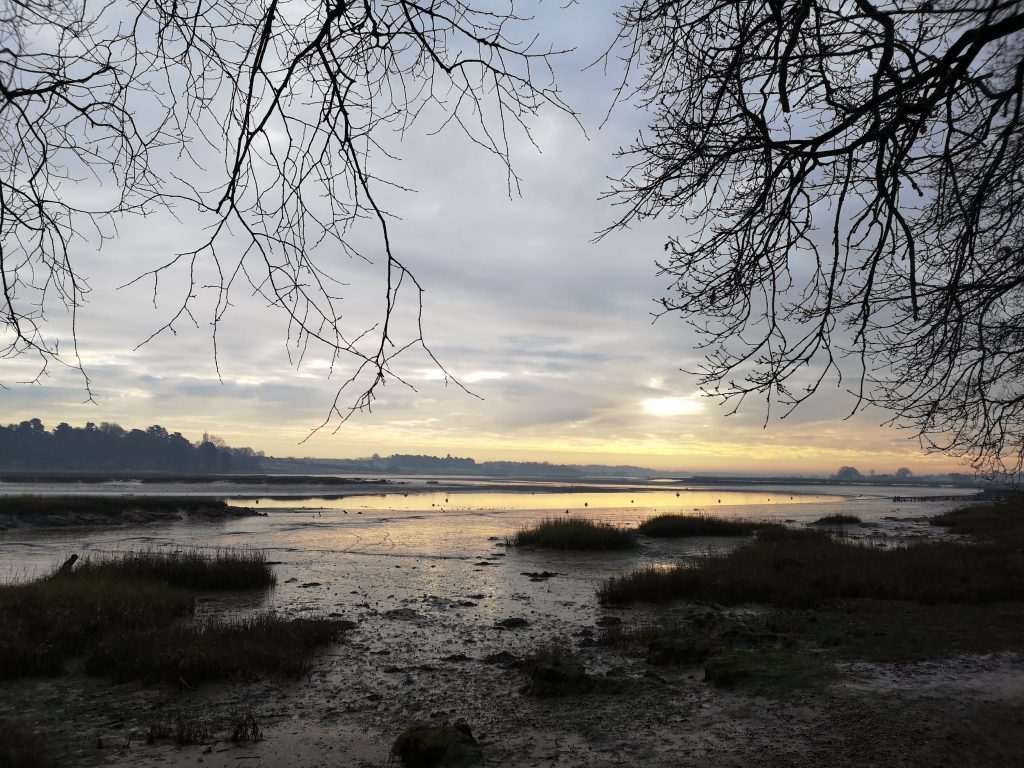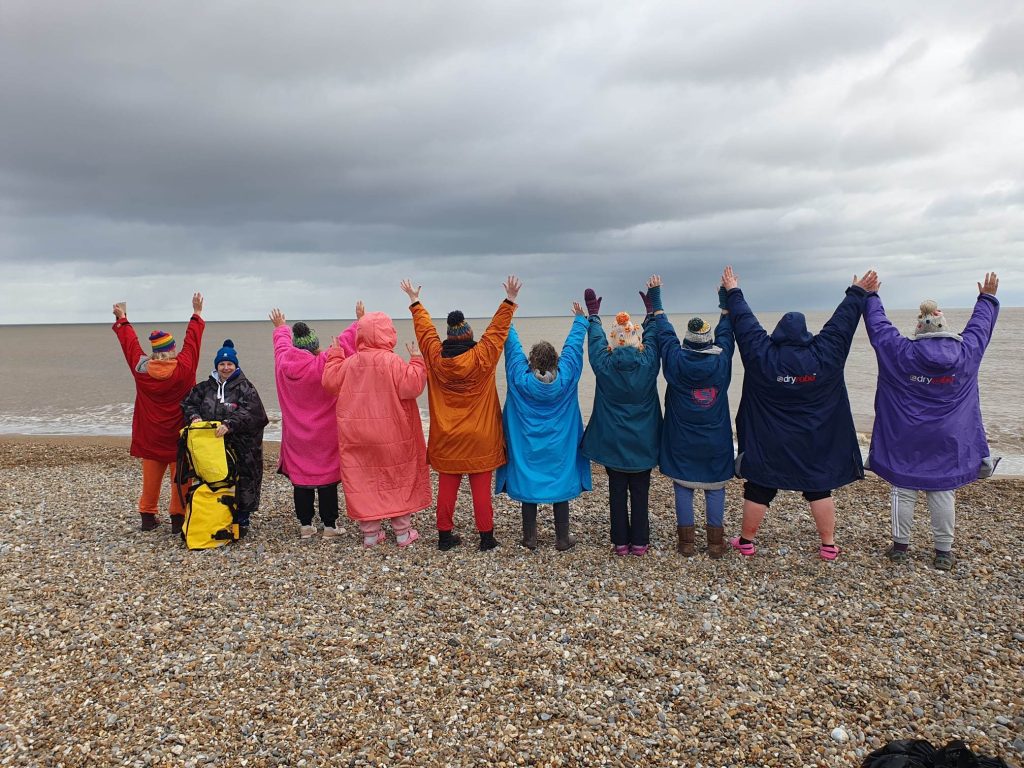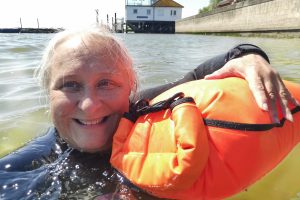By Ruth Leach
This is an extended version of Ruth Leach’s article ‘The Deben Bluetits Swim Group’, published on The Deben #68. It’s written in her capacity as co-founder of the Save the Deben campaign group and contains an update on water quality. This topic is scheduled for panel discussion at the River Deben Association’s forthcoming AGM, April 24th 2024.
During the recent pandemic our lives were deconstructed in so many ways, ‘free time’ – that precious commodity, was suddenly in abundance for many of us. People reconnected with their natural environment and for those fortunate enough to be near a blue space the love affair with nature soon flourished.
Living so close to the river Deben I had the time to rediscover the joy of walking along its banks, while listening to the morning chorus and enjoying the photographic opportunities that the muddy meanders and spectacular sunsets offered.
I soon ventured out into the misty mornings with my kayak and a flask of tea, valuing those moments of being close to the estuarine waterscape, and all of the peace and wellbeing that it bought to my soul.
It was this proximity to nature, the feeling of being an intrinsic part of its timeless cycle, that inevitably drew myself and many others to immerse in the water at the bathing area at Waldringfield and to begin to fully experience the joy of wild swimming in a beautiful, tranquil location.
People have been dipping in the river Deben since pre-Viking times, and whether it was for practical reasons or by accident, I have no doubt that we weren’t the first to have found joy in this healthy recreational pursuit.
While not for the faint-hearted, we were soon joined by other people who spotted our posts on social media and once restrictions were lifted, we started to arrange to meet socially and regular, twice weekly swims, became part of our new routine.
It was fun, it was local and it was free!
We formed friendships as we shrieked at the cold water and squealed as the mud squelched between our toes. We benefitted from the exercise and while many of us only ever swim parallel to the shoreline and don’t venture out of our depth, we began to notice other physical benefits, as well as the boost to our mental health. It’s as if the flush of cortisol rids the body of all the stress chemicals that accumulate during the day causing a completely invigorating refresh of the brain.
My strongest new skillset was to be able to ‘doggy paddle’ while chatting non-stop for about 45 mins – there are so many wonderful conversations to be had within our ‘village’, often to the background music of the piper playing his bagpipes on the cliff during the summer months when the tide coincided with his practice session.
As our numbers grew, we became aware of the national uptake in wild swimming and heard about a group of like-mind outdoor swimmers who were enjoying the waters in Pembrokeshire.
The light hearted group with an equally light hearted title ‘The Bluetits chill swimmers’ was growing rapidly after having been started by triathlete, Sian Richardson in 2014 and by 2022 there were 100 000 ‘Bluetits’ members recorded worldwide.
It wasn’t an official club and as anybody could join, led by Angela Soames and co-founded by myself, our informal collection of lady swimmers quickly becoming affiliated as a local Bluetits group; formalising our meetups and providing the voice of experience to our swimming practice. It made our little group part of a world-wide community who shared common values about the environment, a sense of adventure and a love of cold-water swimming.
Informal swims are posted within the Facebook Group – the ‘Deben Bluetits’, which offers advice about water safety and the times that we are planning to dip. We use high visibility tow floats and wear brightly coloured bathing caps – both for visibility in the water and as a safety device should a fellow Bluetit need a bit of help. We don’t swim alone and are deeply respectful of the natural environment and other water users.
The use of environmentally friendly cosmetics and suntan lotion is informally encouraged to reduce any chemicals being introduced into the river and if ‘double dipping’, a shower is recommended in between locations as well as a change of bathing attire, to avoid carrying plant material and life forms between different water bodies.
Swimming safely is hugely important – wild swimming in the Deben brings its own significant risks from the very strong currents, the powerful tides, river traffic; including yachts and motorised boats, hidden obstacles, the sudden exposure of deep mud when the tide ebbs in some areas and the danger of cold-water shock if the swimmer is not acclimatised.
We always identify an alternative emergency exit point before we enter the water to swim and treat the ebb and flow of the current responsibly and with a very healthy respect, preferring to swim during the last 2 hrs of an incoming tide so if the worst happened, we would be washed upriver rather that out to sea, making rescue a little easier.
The group tends to swim at Waldringfield mostly, but also swims at Woodbridge from Kyson Point and previously from the Town Steps jetty, while there is another group ‘The Shingle Street Bluetits’ that swim in the salt water lagoon at Shingle Street. All three areas are very beautiful are classified as SSSIs and part of our National Landscapes, previously known as AONBs.
Sometimes our intrepid swimmers even venture out on a ‘Tits on Tour’ adventure to explore other swim spots and meet up with other open water swim groups. The current admins are an inspiring, passionate group of all year-round swimmers – recently, as red as lobsters, they had to break the ice as they went into the water for their early morning swim. Men are also welcome to join in as it has evolved from the circle of ladies that first used to meet up.
During this period of awakening there was an elephant in the room which soon became very clearly identified, while still huge, it turned out not to be of mammalian origin but rather the tiny microscopic organism, Escherichia coli (E.coli) that was contributing to the problems in water quality.
The ‘State of our Rivers’ review was published in 2021 by the environmental audit committee chaired by the right honourable Lord, and its content caused many swimmers to leave the water until something was done about it.
Anecdotally there were reports of tummy upsets and ear infections after swimming although establishing a direct causative link to E.coli without microscopic cultures was not possible.
According to the report, few of our rivers met good ecological status with 40 % of the contamination being ascribed to farmland run off of phosphates, pesticides and slurry and the remaining 60 % from diffuse urban pollution caused by road runoff (30%) including microplastics, rubber particles from tyres, hydraulic fluid from brakes and the remaining 30% caused by the presence of E.coli , phosphates and pharmaceuticals from the local waste water recycling plants. Anyone who ventures out onto the river when looking back at Woodbridge, can’t help but notice that the river very naturally flows between the elevated areas of Sutton Hoo on one side and Woodbridge Town with a human population of approximately 10 000 on the other side.
Anything generated by our human activity will be carried down into the river, whether washed there by rain water or emptied into the river via the sewage system by the water company. Bearing in mind the 60:40 split between the sources of contamination, our behaviour both at personal level and behaviour of the water companies affects the state of the Deben every single day.
The levels of E.coli identified locally by the Woodbridge Climate Action Centre citizen scientist group, led by Eamonn O’Nolan initially, were significantly above normal or safe, in the river Deben, especially in Martlesham Creek where the outlet drains from the waste water recycling plant run by Anglian Water.
The high levels were ascribed to sewage emptying into our rivers. E.coli can also be present due to the faecal contribution of seals, otters, fish and birds and the genetic confirmation of the source can only be obtained by carrying out prohibitively expensive microbial source tracking (MST). This is the reason why when there is a super high tide the nesting sites of the overwintering bird population on the Deben is breached and the guano is washed into the river, causing a spike in E.coli and the reason we don’t swim after heavy rains or a Spring tide. Because the waste Water from the treatment plant empties out into the river it is believed that this is the source.
The Rivers Trust shares a Sewage Map where you can see where the sewage outlets are in Woodbridge and how many hours of storm overflows (when untreated effluent is released by the plant due to high volume, often caused by heavy rain or possible mechanical malfunction. If high rain it is at least partially diluted but if it is a blockage or breakdown what is flushed is what is in the river in its original form) take place.
https://theriverstrust.org/sewage-map
Caroline Page (left) and Ruth Leach (right), co-founders of Save The Deben.
The campaign group ‘Save The Deben’ was set up by the late Caroline Page and Ruth Leach and a protest involving approximately 200 people marched through Woodbridge and along the riverside demanding that the water company ‘clean up their act’ in 2022.
Many meetings followed between the campaign group, the citizen scientists and the water company and aided by a national campaign, run by Surfers Against Sewage, Anglian Water’s Coastal Catchment Manager, Greg Hall supported us in submitting an application for designated bathing water status at Waldringfield and Woodbridge. It was a huge task and took hours of work carried out solely by the now terminal Caroline Page and myself and the wonderful Woodbridge and Waldringfield communities. Sadly, The MP for Suffolk Coastal, Dr Therese Coffey was not able to support us because it was a conflict between her constituency and ministerial duties. So, we did it on our own from Caroline’s literal deathbed!
The importance of this status is two-fold, if granted it means that the environment agency will test the water for e.coli weekly, during the May to September swim season and will share the results publicly and after 4 years of data they will award a classification to the area as an indication of water quality.
While this information, although retrospective, is useful for all recreational river users and it clearly has a public health benefit but it’s the bigger environmental benefit that our campaign group was chasing.
Where there are elevated E.coli levels, there are also phosphates, pharmaceuticals, forever chemicals (PFA’s from non-stick and a multitude of common household products, synthetic surfaces and fire extinguisher foams) and micro plastics (remember that 60:40 split of pollutants).
The high presence of phosphates causes an environmental imbalance triggering the process of eutrophication in which the river water becomes overly enriched with nutrients and algae and plankton flourish. This results in the depletion of dissolved oxygen and the subsequent deterioration of water quality, and the area can no longer support life. It finally becomes a ‘dead zone’.
So, the Holy Grail that we are actually chasing with the Designated Bathing Water Status (DBWS) application is the set of restrictions that are placed on the water company by the government concerning the process by which the waste is treated and the effluent discharged, in proximity to a bathing area. These restrictions oblige the water company to ‘clean up its act’.
Further, it allows Ofwat to grant permission to Anglian Water for the expenditure of the water company to be invested in improvements within a 5 year timescale as opposed to the usual 10 year process.
These improvements were to include a performic acid (formic acid – yes, originally from ants, and hydrogen peroxide) disinfection pilot plant study at Waldringfield and a phosphate removal plant at Wickham Market.
Sadly the performic acid pilot was not accepted by the Environment Agency because while it is proven to kill E.coli it was feared it may mask the presence of other viruses and bacteria and so provide a falsely positive safety profile at Woodbridge and Waldringfield. It was a huge but necessary disappointment for the campaigners, citizen scientists and the water company working with us but at least the phosphate removal plant is going ahead. The possibility of UV disinfection is now being considered at Martlesham.
The application for DBWS was successful and last year Waldringfield became the first tidal estuary in the UK to receive the status – a huge thank you to all who supported this effort. From the swimmers who were counted, the landowners granting their permission and the multitude of other people that contributed in so many ways thank you from the bottom of my campaigning heart – you have truly made a measurable difference to the environment and the recovery of our river. Unfortunately Woodbridge did not meet the criteria as our swimmer counts took place at 3 sites and Defra would only consider a single site, splitting the numbers down meant we didn’t make the threshold of 100 bathers (people paddling and swimming) in the water in a day.
So why do we continue to swim?
Because we are so keen to acquire the environmental benefits of the obligations placed on the water companies when DBWS is granted to a patch of water, we decided to get back in the Deben so that we could be counted in the bather counts in order to fulfil the Kafaesque requirements set out by DEFRA for a DBWS application.
Supported by Surfers Against Sewage (SAS) we started swimming again at Woodbridge, limiting it to the slot two hours before high tide to benefit from the effect of tidal dilution on pollutants in the water. SAS sponsored testing of the water sampled weekly when we swam which was carried out at an external, accredited laboratory. The results were negative for E.coli and were corroborated by citizen science testing.
So, our risk paid off and the water was safe for us two hours before high tide. The 2nd application for Woodbridge was planned. The number counts were above the threshold, all of the DEFRA boxes were ticked but unfortunately in March 2023 the granting of a licence to a River Boat tour group by the East Suffolk Council raised safety concerns for the bathers.
The Town Steps are available for all to access the water and this includes usage by swimmers, crabbers, paddle boarders and kayakers and it is a place where the swimmers and the river tour operators treat one another with courtesy and mutual respect.
I strongly support the growth of our local economy but it means that I can no longer encourage swimming here. As a campaign group we have been working very closely with the ESC proposing a pontoon styled marked off ‘No Boats allowed’ space accessed from the Town Steps where swimmers could be protected, our DBWS application could be submitted, Yoga paddle board classes could be held and the Sea Scouts and Deben Canoe club could practice their kayaking skills. Sadly, as the swimming season opens in May and the weather is warming up this has not yet been achieved, simply because we can’t identify a place that works for everyone.
There has been a surge in popularity of many recreational water sports on the River Deben, and a spirit of mutual respect needs to exist between all river users. While the effect of tidal dilution has been our saviour with regards to water quality both at Woodbridge and Waldringfield, the awarding of designated bathing status at Waldringfield means that the water there will be monitored for e.coli by the Environment Agency during the May to September swimming season 2024. It was hoped that we would submit a bid for Woodbridge in 2024 but I am holding off due to safety concerns – boats and swimmers don’t mix and at Woodbridge we are working hard with the local authorities to explore the possibility of an area that can be set aside for swimmers.
Once our swimmers are safe at Woodbridge and the boat users and sailors are happy, we will submit the application for Woodbridge so that our Bluetits can fledge here as well.
So where does that leave us in terms of water quality?
The river Deben can be split into two areas; the tidal Deben with its transitional waters from Wilford Bridge to Felixstowe which benefits from the effects of tidal dilution and the Upper Deben, from approx. Debenham to the Wilford Bridge which is polluted from the many sources mentioned earlier in this article and faces the further challenges of abstraction.
David Findley and Bill Brammer of the Deben Climate Centre have done an excellent job in the stewardship of the Upper Deben, running regular ‘safaris’ the length of this stretch monitoring the phosphate levels. Many other organisations such as the RDA, the Deben Estuary Partnership and the Essex and Suffolk Rivers Trust are working towards the goals of enabling the recovery the River Deben. Save the Deben Campaign group continues to campaign and Transition Woodbridge make a huge contribution with their litter picks.
But the evidence presented in the study carried out by Dave Findley and Bill Brammer says more than I possibly can – please follow the link below, download the report and read their findings – this will highlight the severity of the situation.
This is written in my role as Co-founder of the Save The Deben Campaign group.
Ruth Leach
Ruth Leach is a photographer, campaigner and county councillor.
For more information about the Bluetits Chill Swimmers and view their code of safety please visit: thebluetits.co/pages/dont-be-a-tit-be-a-bluetit-swim-safety-resources.

